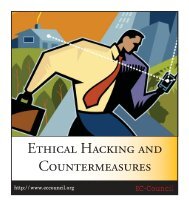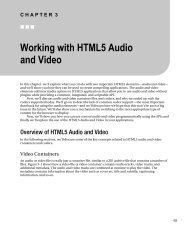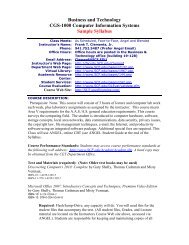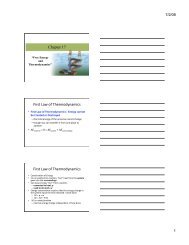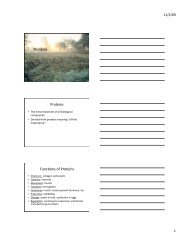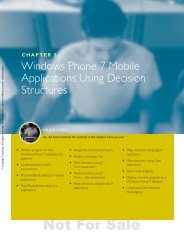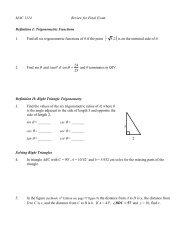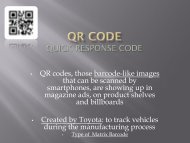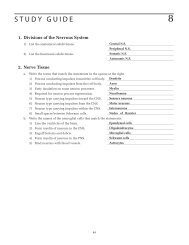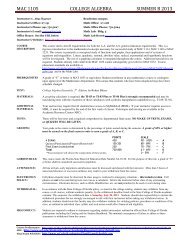Clinical Competency Evaluation Handbook Daily Clinical ...
Clinical Competency Evaluation Handbook Daily Clinical ...
Clinical Competency Evaluation Handbook Daily Clinical ...
You also want an ePaper? Increase the reach of your titles
YUMPU automatically turns print PDFs into web optimized ePapers that Google loves.
STATE COLLEGE OF FLORIDA, MANATEE-SARASOTA<br />
HEALTH PROFESSIONS DIVISION - RADIOGRAPHY PROGRAM<br />
BRADENTON CAMPUS<br />
<strong>Clinical</strong> <strong>Competency</strong> <strong>Evaluation</strong> <strong>Handbook</strong><br />
and<br />
<strong>Daily</strong> <strong>Clinical</strong> Examination Log<br />
for<br />
STUDENT RADIOGRAPHERS<br />
MISSION STATEMENT<br />
THE MISSION OF THE RADIOGRAPHY PROGRAM IS TO PROVIDE THE COMMUNITY WITH<br />
COMPETENT AND CARING ENTRY-LEVEL RADIOGRAPHERS WHO ARE ABLE TO PERFORM QUALITY<br />
RADIOGRAPHIC PROCEDURES AND FUNCTION AS AN INTEGRAL MEMBER OF THE HEALTH-CARE<br />
TEAM. IN ORDER TO ACHIEVE THIS, THE PROGRAM PROVIDES THE STUDENT WITH INNOVATIVE<br />
EDUCATIONAL OPPORTUNITIES TO PREPARE FOR A REWARDING CAREER IN RADIOLOGIC<br />
TECHNOLOGY.<br />
PROGRAM GOALS<br />
THE GOALS OF THE RADIOGRAPHY PROGRAM ARE AS FOLLOWS: 1. THE PROGRAM WILL PROVIDE<br />
STUDENTS WITH EDUCATIONAL AND CLINICAL OPPORTUNITIES THAT PROMOTES ENTRY-LEVEL<br />
COMPETENCY IN RADIOLOGIC TECHNOLOGY. 2. THE PROGRAM WILL ASSURE THAT IT MEETS THE<br />
. .<br />
NEEDS OF THE HEALTHCARE COMMUNITY, AND THE CURRICULUM REFLECTS THE CURRENT<br />
PRACTICE OF THE PROFESSION. 3. THE PROGRAM WILL PROVIDE AN EDUCATIONAL<br />
ENVIRONMENT THAT ENCOURAGES EFFECTIVE COMMUNICATION, CRITICAL THINKING, AND<br />
LIFELONG LEARNING.<br />
Reviewed and Revised 7/19/10
STATE COLLEGE OF FLORIDA, MANATEE-SARASOTA<br />
RADIOGRAPHY PROGRAM<br />
STUDENT'S NAME: ------------------<br />
ADDRESS:<br />
(optional) ---------------------<br />
SEMESTER:<br />
CLINICAL EDUCATION SITE:<br />
---------------<br />
DATES _________ to _<br />
ATTENDED
CONTENTS<br />
Description Pagels)<br />
Explanation of<strong>Competency</strong> <strong>Evaluation</strong> ... .................... .......... ........... 1 - 6<br />
<strong>Competency</strong> <strong>Evaluation</strong> Form ,. 7,8<br />
<strong>Daily</strong> Log Sheet '" ............................................... .... ...... ........................... 9<br />
<strong>Clinical</strong> <strong>Evaluation</strong> Form (midterm and final) 10 - 12<br />
<strong>Competency</strong> <strong>Evaluation</strong> Check-Off Form 13 - 15<br />
CES Summary - Task Analysis/Orientation/Sterile Tray/ Random Exams Form... 16<br />
Laboratory Simulation Check-Off Form 17, 18<br />
Task Analysis For Radiographic Rooms '" 19,20<br />
Task Analysis For Portable and C-Ann '" 21<br />
Task Analysis For Sterile Tray Setup 22<br />
RoomlDept. Objectives 23<br />
Main Work Area Objectives 24<br />
Transportation Objectives ,. " , , 25<br />
Policy - Procedure Participation Documentation 26<br />
Procedure Participation Checklist Form '" '" '" 27<br />
Policy - Uniformed Absence 28<br />
Policy - One Student-One Patient Ratio '" '" ... ... .. .. 29<br />
Policy - When <strong>Clinical</strong> InstructorIs Not On The Premises 30<br />
Policy - Venipuncture 31<br />
Policy - Equitable Exam Policy : ,.......... 32<br />
Policy - Fluoroscopic GI <strong>Competency</strong> Overhead Images - Minimum Requirements 33<br />
Limitations ofUnsuccessful <strong>Competency</strong> Attempts '" .. , '" ,. 34<br />
Maximum Number of Unsuccessful <strong>Competency</strong> Exams 35<br />
Policy - Imaging Modality Observation Requirements '" 36,37
<strong>Clinical</strong> Documents Checklist Summary , '" '" , , ..<br />
<strong>Clinical</strong> Orientation Task Analysis Form .. , .. 39<br />
Absence and/or Late Form<br />
Lab Simulation Performance <strong>Evaluation</strong> .. 41<br />
Student <strong>Clinical</strong> Rotation <strong>Evaluation</strong> (Biweekly) .. 42<br />
Due Process Flow Chart For Students Who Are Performing Satisfactory , 43<br />
Due Process Flow Chart For Students Who Are Not Performing Satisfactory . 44,45<br />
Policy - Random <strong>Competency</strong> Guidelines '" .. , '" '" . 46<br />
Policy - <strong>Competency</strong> Exam Deadlines (for GI, decub. Abdomen, XTL hip) 47<br />
<strong>Clinical</strong> Education Site - Student Rotation form 48<br />
Policy - Random <strong>Competency</strong> Deadlines and Maintenance ... '" ...... ... ... ... ... 49<br />
Policy - Simulating Mandatory <strong>Clinical</strong> Competencies and Electives '" .. ,." 50<br />
..<br />
38<br />
40
EXPLANATION OF COMPETENCY EVALUATION<br />
Now that you have been introduced to Radiography, it is time to present to you the competency<br />
evaluation system.<br />
<strong>Competency</strong> is defined as "having requisite or adequate ability or qualities: have the capacity<br />
to function or develop in a particular way" (Webster's Dictionary). This is accomplished through<br />
didactic study, laboratory practice and clinical performance. The old adage "practice makes perfect" is<br />
applicable to this segment of your education.<br />
In radiology, there are numerous positions used to obtain diagnostic images. Of these, many are<br />
used as routine studies. Your objective in this Program is to learn these procedures, correctly perform<br />
them, demonstrate competence through the competency evaluation system and maintain that competency.<br />
When you initially report to your clinical assignments, you will be observing and assisting the<br />
Radiographers while they perform various procedures. As you progress, you will be able to perform the<br />
procedure with less assistance from the Radiographer.<br />
At the same time, you will be given didactic information on various procedures/exams during the<br />
procedures courses. Some of this information will be immediately supported in the clinical setting and<br />
some will be used at a later date. Likewise, you will see and may very well be asked to perform<br />
procedures for which you have no didactic preparation. This limitation does not mean you cannot<br />
perform the procedure. In fact, you can perform ANY procedure, under DIRECT supervision*.<br />
Remember to have all requisitions checked by a registered Radiographer (ARRT). A registered<br />
Radiographer (ARRT) prior to the Radiologist interpretation must evaluate all radiographic images taken.<br />
In order to assure the safety of patients and students, student supervision in the clinical setting is based on<br />
student competence. Prior to proving competency in a radiographic procedure, the exam is conducted<br />
under direct supervision.<br />
* Direct supervlSlon as defined in the Standards for an Accredited Educational<br />
Program in Radiologic Sciences (JRCERT) is "Student supervision under the following<br />
parameters:<br />
"Student supervision by a qualified practitioner who reviews the procedure in relation to<br />
the student's achievement, evaluates the condition of the patient in relation to the student's<br />
knowledge, is present during the procedure, and reviews and approves the procedure. A<br />
qualified radiographer is present during student performance of a repeat of any<br />
unsatisfactory radiograph".<br />
Also, the examinations you have assisted with or those you have performed with indirect<br />
supervision are to be recorded in the daily log book along with other information such as the correct date,<br />
examination, patient ID number, assisted (direct supervision) or unassisted (direct or indirect supervision)<br />
A registered radiographer's initials are required on all completed procedures.<br />
Once you have been presented with the material in the procedures course, pass a laboratory<br />
assessment on that procedure, complete at least one (1) unassisted examination under direct<br />
supervision (see exceptions on page 5), and feel competent to perform the procedure satisfactorily by<br />
yourself, notify the clinical instructor. He or she will evaluate you, or assi2n a certified evaluator to<br />
evaluate you, as you perform the next examination of this type to come to the department, regardless of<br />
the patient's condition. A certified evaluator should only be utilized when the <strong>Clinical</strong> Instructor (CI) is<br />
1
Summary of Steps Students Must Follow<br />
1. Have studies presented to you in the procedures courses.<br />
2. Complete a lab simulation of that procedure and record<br />
in the logbook. A lab simulation is not required on all procedures. (see pgs. 17, 18)<br />
3. Have all requisitions checked by a qualified radiographer (ARRT)<br />
4. Perform procedures under DIRECT supervision until competent<br />
(Mark cases in appropriate spot in logbook and have initialed where<br />
necessary)<br />
5. Have all images verified by a registered radiographer prior to<br />
being submitted to a Radiologist.<br />
6. Satisfactorily perform at least one unassisted study and record with<br />
appropriate initial from a qualified Radiographer. (see exceptions on pg. 5)<br />
7. Contact the clinical instructor (who may appoint a certified evaluator) or<br />
Program faculty for competency evaluation<br />
8. Continue to perform exams satisfactorily with INDIRECT<br />
supervision in order to maintain competence.<br />
9. Keep records up-to-date.<br />
10. If your performance should become less than satisfactory for any procedure you<br />
have completed the competency exam on, that competency will be retracted (CI or<br />
faculty will "white out" exam in log book) and you will be required to repeat the<br />
entire competency procedure process over.<br />
*REFER TO FLOW CHART (pg.6)<br />
On the following pages you will find a daily log for you to record your clinical experiences. Under<br />
each clinical day you will note spaces for you to log the examination performed, patient's ID number,<br />
assisted (direct supervision), unassisted (direct or indirect supervision), staff initials and time of study.<br />
Upon arriving at their respective clinical facility the student is required to log into the designated<br />
computer and clock in. Also before leaving the facility for the day, the student is required to clock out<br />
from the designated computer. On the bottom of each log sheet is a section for radiographer's comments<br />
and overall performance evaluation, which may be completed by a registered radiographer whom you<br />
worked with the most during that day. When you finish for the day, your clinical instructor will validate<br />
the page by placing their initials where indicated. Note: A staff radiographer or a clinical instructor with<br />
whom you worked with the most, will be filling out a Bi-Weekly <strong>Evaluation</strong> during your rotation in that<br />
area of the CES. (Le. ER, OR, etc.)<br />
This log is part of the student record and is expected to be kept up-to-date at all times. It will be<br />
reviewed daily by the clinical instructor, and periodically by faculty. The logbook will be handed in at the<br />
end of each semester so that faculty can check clinical progress and verify that minimum requirements<br />
have been met. The completed log sheets will be retained by the clinical coordinator and new sheets for<br />
next semester will be handed out to replace the ones that were used during that semester. Any falsification<br />
of these documents will be grounds for dismissal pending a hearing by those involved in your clinical<br />
experience.<br />
Probation is a process by which students are informed that they are not satisfying the requirements of the<br />
Radiography Program. For other unsatisfactory performance, not warranting probation, a letter of warning<br />
will be issued stating the reason for the letter, and the corrective action needed for improvement. If<br />
unsatisfactory performance continues, the student will be placed on probation.<br />
4
The procedures explained in this booklet are subject to change by written<br />
notice from the Program Faculty at any time.<br />
MINIMUM NlTMBER OF COMPETENCIES<br />
TO BE COMPLETED<br />
REQUIRED BY MIDTERM<br />
Practicum I 5* including (KUB) o<br />
Practicum II 10* 5<br />
Practicum III A & B 12* 6<br />
Practicum IV 13* 6<br />
Practicum V 12* 6<br />
*Practicum I through N requires one random competency. Practicum V requires six random terminal<br />
competencies (see pg. 46) (one from each of the following categories - gastrointestinal, spine,<br />
genitourinary, mobile/portable, extremities, and trauma). If a terminal competency is completed by a<br />
certified evaluator, documentation from the clinical instructor must be included that assures the clinical<br />
instructor was not available to perform the random competency. Also refer to pages 25 and 26 in this<br />
book on "Procedure Participation Documentation" which is required for all Practicums.<br />
PORTABLE PROCEDURES<br />
NOTE: For portable procedures, an UNASSISTED is NOT REQUIRED if the student has<br />
satisfactorily completed a competency in that procedure in the department. If this has not been<br />
accomplished, the student must perform an UNASSISTED, either a portable or in the other areas where<br />
images are performed, prior to that portable competency. The only exception to this is chest radiography.<br />
An UNASSISTED portable MUST be completed prior to doing a portable chest.<br />
UNSATISFACTORY CLINICAL COMPETENCY<br />
PROCEDURE POLICY<br />
When a student unsatisfactorily attempts a competency procedure, for the first time, the student must<br />
complete the required remediation activities as designated by the program faculty and then may re-attempt<br />
the competency exam. If the student unsatisfactorily attempts the competency procedure during a second<br />
attempt, the student must complete the required remediation activities in addition to completing an<br />
unassisted exam before re-attempting the competency exam for the third time. (see flow chart pg. 6)<br />
UNASSISTED EXAM EXEMPTIONS<br />
The requirement of obtaining an unassisted exam is waived for all elective procedures. This waiver also<br />
applies to the following mandatory procedures: all fluoroscopic procedures, trauma cervical spine, 6-yearold<br />
or younger chest; trauma extremity; all exams of the cranium; plus all portable procedures (except<br />
chest) if a competency has been satisfactorily completed in that portable procedure, in the department (as<br />
explained above).<br />
5
OVER-RIDING CRITICAL ELEMENTS FOR ALL PROCEDURES<br />
RADIOGRAPHY PROGRAM<br />
THE STUDENT WILL:<br />
1. Evaluate the patient's requisition identifying the procedure to be<br />
performed; (the patient's name, and age; the ordering physician; mode of<br />
transportation, etc).<br />
2. Evaluate the patient's chart to identify the name of the patient; procedure<br />
validity by checking physician's orders; any unusual precautions or concerns<br />
that need to be taken.<br />
3. Confirm patient identity by observation and verbal acknowledgment prior to<br />
performing a procedure. If verbal is not possible, documented observation<br />
will take place.<br />
4. Appropriately document and/or discuss (with appropriate personnel)<br />
information acquired from patient.<br />
5. Assess patient risk factors for procedures requiring the use of contrast<br />
media.<br />
6. Wash hands before and after each procedure.<br />
7. Demonstrate the use of isolation precautions at all times.<br />
8. Explain the procedure being performed in an understandable manner to the<br />
patient.<br />
9. Confirm the patient's pregnancy status by asking a female under the age of<br />
55 the appropriate pregnancy questions and documenting their response.<br />
10. Confirm that all radiopaque materials that may interfere with the procedure<br />
have been removed.(according to the affiliate protocol)<br />
11. Prepare the exam room for the procedure to be performed.<br />
12. Use personal and patient shielding during the procedure (except when<br />
interfering with the procedure being performed)<br />
13. Demonstrate quality patient care and professional rapport throughout the<br />
procedure.<br />
14. Demonstrate the ability to adapt to any change in a patient's condition.<br />
15. Perform the procedure in a timely manner which does not compromise the<br />
patient or the facility.<br />
16. Identify the structure being radiographed with the correct lead and/or<br />
electronic marker(s) and ensure that the marker(s) is/are visible on the<br />
finished radiograph (image) and outSide of the area of interest based on<br />
facility protocol.<br />
17. Ensure that the patient's "ID" is on the finished radiograph (image).<br />
18. Properly complete paperwork, and submit images for interpretation.<br />
19. Appropriate image receptor orientation as indicated by proper: blocker<br />
location; indicator. (color) bar location; or correct landscape/portrait<br />
selection.<br />
NOTE:<br />
THE ABOVE OBJECTIVES MUST BE PERFORMED PROPERLY FOR A<br />
SUCCESSFUL COMPETENCY. IF ANY ARE NOT, THE COMPETENCYIS<br />
UNSATISFACTORY AND THE STUDENT MUST PROCEED AS STATED IN THE<br />
"COMPETENCY EVALUATION HANDBOOK."<br />
7
DAILY LOG SHEET<br />
Day# _ Date _ CI Initials ----<br />
Time arrived _<br />
1<br />
2<br />
3<br />
4<br />
5<br />
6<br />
7<br />
8<br />
1<br />
19<br />
10<br />
11<br />
12<br />
h;<br />
14<br />
15<br />
16<br />
17<br />
18<br />
Examination Performed<br />
Area Assigned _<br />
Left _ Total hours in clinic _<br />
DIRECT!<br />
INDIRECT<br />
(D ORID)<br />
Patient ID# A<br />
(A) assisted (VA) unassisted - no help given except lifting help if needed<br />
optional comments<br />
9<br />
U<br />
A<br />
Staff<br />
Initials Time
State College of Florida, Manatee-5aras6ta<br />
RADIOGRAPHY PROGRAM<br />
CRITERIA FOR CLINICAL EVALUATION FORM<br />
(minimum criteria)<br />
NOTE: THIS IS AN EVALUATION OF THE ENTIRE SEMESTERS PERFORMANCE<br />
WHEN DOING THE FINAL EVALUATION!!<br />
1. Interpreted physicians' orders correctly in determining radiographic procedures to be performed.<br />
A. the student satisfactorily interpreted requisitions for the procedures performed.<br />
B. the student satisfactorily interpreted physicians' orders for the procedures performed.<br />
C. the student satisfactorily interpreted other orders for the procedures performed.<br />
2. Documents information acquired from the patient appropriately<br />
A. the student documented patient information as required by the protocol for the facility.<br />
B. the student documented patient history in the appropriate manor as required by the protocol of the facility.<br />
C. the student documented all other pertinent information as required by the protocol of the facility.<br />
3. Demonstrates performance of radiographic procedures.<br />
A. the student demonstrated knowledge through proper position, use of equipment. etc. to assure a satisfactory result.<br />
B. the student demonstrated knowledge by answering questions satisfactorily about the procedures performed.<br />
C. the student demonstrated knowledge by performing procedures with little difficulty and in a timely manner.<br />
D. the student performed procedures in such a way that the patients safety was not jeopardized.<br />
E. the student performed the procedures using proper exposure factors in such a way as to achieve a diagnostically<br />
acceptable image without jeopardize the patients safety.<br />
F. the student demonstrated effective positioning without jeopardizing the safety of the patient.<br />
G. the student demonstrated proper use of eqUipment without jeopardizing the safety of the patient.<br />
H. the student demonstrated knowledge and proper performance of medical and surgical asepsis as required by the protocol<br />
of the facility.<br />
4. Utilizes problem-solving skills to make appropriate decisions related to patient care'and procedures.<br />
A. the student demonstrated the use of problem solVing skills when the need was there.<br />
B. the student demonstrated good decision making skills for the level of competency at the time of the procedure.<br />
5. Requests supervision in performing procedures if required level of competency has not been met.<br />
A. the student did not perform any procedure without direct supervision unless they had satisfied the protocol of the program<br />
with regard to the competency evaluation criteria.<br />
B. the stUdent did perform those procedures which were satisfactorily completed through the competency evaluation<br />
procedure with continued competence.<br />
C. the student demonstrated good sense when patient condition required a more experienced, qualified Radiographer for<br />
successful completion.<br />
D. the student asked for assistance when a situation was outside their knoWledge and/or experience level.<br />
E. the student demonstrated knowledge of the available resources and when to use them.<br />
6. Employs legal and ethical guidelines in administering patient care.<br />
A. the student followed legal and ethical gUidelines in administering patient care.<br />
B. the student followed the ethical standards of the American Society of Radiologic Technologist.<br />
C. the student followed the guidelines established by the facility as presented in the orientation of the student.<br />
D. the student recognized their limitations in the clinical environment and did not knOWingly communicate untrue or misleading<br />
information.<br />
E. based on pertinent HIPAA criteria, the student maintained confidentiality at all times with regard to all issues in the clinical<br />
setting.<br />
F. based on pertinent HIPAA criteria, the student maintained confidentiality regarding information about others.<br />
G. the student used the proper channels to solve problems or to seek information.<br />
H. the student recognized the proper chain of communication when dealing with the patient and the physician.<br />
I. the student followed proper procedures if a competency was not satisfactory completed '<br />
7. Demonstrates initiative by seeking out learning experiences.<br />
A. the student sought out procedures to be performed based on their level of competency.<br />
B. the student did not avoid procedures to be done when an opportunity for gaining further knowledge was at hand.<br />
C. the student was eager to help with procedures even if they had little or no prior knowledge of that procedure.<br />
D. the student leamed other things about the facility, department, equipment etc. when not performing procedures to increase<br />
their competency.<br />
8. Demonstrates behaviors which show empathy and appropriate interpersonal skills with patients and the health care team.<br />
A. the student demonstrated proper use of terminology when carrying on a conversation with anyone.<br />
B. the student demonstrated empathy and respect to everyone they came in contact with.<br />
C. the student maintained good rapport with the patient.<br />
9. Adheres to program/affiliate policies and procedures.<br />
A. the student followed all program policies and procedures satisfactorily.<br />
B. the student followed all affiliate policies and procedures which apply to them satisfactory<br />
C. Effectively maintains a clinical journal.<br />
10. Performed the number of competencies reqUired at the time of this evaluation<br />
A. the student performed the number of reqUired competencies by mid-term and the end of the semester satisfactorily.<br />
B. the student performed the proper number of RANDOM competencies.<br />
.RniIed 1011006; Rniewed 712008, 71200'<br />
C:\Gowenk\Radiography\Fornu\C'lfnkaI Xval Fvrm #Ill<br />
11
COMPETENCY EVALUATION CHECK-OFF<br />
UNASSISTED COMPETENCY<br />
Unsatisfactory<br />
Competencies<br />
EXAMS DATE AFFILIATE . EVAL ' DATE AFFILIATE EVAL DATE(S)<br />
CHEST AND THORAX<br />
1. Chest, Routine<br />
2. Ribs<br />
3. Chest AP and Lateral (Wheelchair<br />
or Stretcher)<br />
4. Upper Airway (Soft-tissue neck)* X<br />
X X<br />
5. Chest Lateral Decubitus* X X X<br />
6. Sternum* X X X<br />
UPPER EXTREMITY<br />
1. Finger or Thumb '.<br />
2. Hand<br />
3. Wrist<br />
4. Forearm<br />
5. Elbow<br />
6. Humerus<br />
7. Shoulder<br />
8. Trauma Shoulder (scapular Y,<br />
transthoracic or axillary)<br />
9. Clavicle*<br />
X X X<br />
X X X<br />
10. Scapula* X X X<br />
11. AC Joints* X X X<br />
12. Trauma: Upper Extremity<br />
(nonshoulder)<br />
LOWER EXTREMITY<br />
1. Femur<br />
X X X<br />
2. Trauma: Lower Extremity X X X<br />
3. Foot<br />
4. Ankle<br />
5.Knee<br />
6. Tibia-Fibula<br />
7. Patella* X X X<br />
8. Toe* X X X<br />
9. Calcaneous (as Calcis)* X X X<br />
CRANIUM<br />
1. Facial Bones* X X X<br />
2. Nasal Bones* X X X<br />
13
COMPETENCY EVALVATlON CHECK-OFF<br />
Unsatisfactory<br />
UNASSISTED COMPETENCY Ct' ompe encles<br />
EXAMS DATE AFFILIATE EVAL DATE AFFILIATE EVAL DATE(S)<br />
3. Paranasal Sinuses X X X<br />
4. Skull X X X<br />
5. Orbits* X X X<br />
6. Zygomatic Arches* X X X<br />
7. Mandible* (Panorex acceptable) X X X<br />
SPINE AND PELVIS<br />
1. Cervical Spine<br />
2. Trauma Series Cervical Spine<br />
Including (XTL)#<br />
3. Thoracic Spine<br />
4. Lumbosacral Spine<br />
5. Pelvis<br />
6. Hip<br />
X X X<br />
7. Trauma Hip Series including<br />
(XTL)+<br />
8. Scoliosis Series* X X X<br />
9. Sacrum and/or Coccyx* X X X<br />
10. Sacroiliac Joints* X X X<br />
ABDOMEN<br />
1. Abdomen Supine (KUB)<br />
2. Abdomen Decubitus or Upright<br />
+<br />
3. Intravenous Urography* X X X<br />
FLUOROSCOPY STUDIES<br />
1. Upper GI Series+ (single or<br />
double contrast)<br />
X X X<br />
2. Small Bowel Series+* X X X<br />
3. Barium Enema (single or<br />
double contrast)+ .<br />
X X X<br />
4. Esophagus* X X X<br />
5. Cystography/Cystourethrograpy* X X X<br />
6. ERCP* X X X<br />
7. Myelography* X X X<br />
8. Arthography* X X X<br />
14<br />
\
MOBILE AND SURGICAL Date Affiliate Eval. Date Affiliate Eva!. Date(s}<br />
1. Portable Chest<br />
2. Portable Abdomen<br />
3. Portable Orthopedics<br />
4. C-Arm Procedure (surgical)<br />
X X X<br />
5. Surgical<br />
Cholangiography*<br />
6. Retrograde Pyelography* X X X<br />
STERILE PROCEDURE<br />
Any procedure requiring a sterile<br />
tray to be setup and used.<br />
Procedure performed - X X X<br />
PEDIATRICS (age 6 or younger)<br />
1. Chest Routine<br />
2. Upper Extremity*<br />
3. Lower Extremity*<br />
4. Abdomen*<br />
5. Mobile Study*<br />
UNASSISTED COMPETENCY<br />
Unsatisfactory<br />
Ct' ompe enCles<br />
DATE AFFILIATE EVAL DATE AFFILIATE EVAL DATE(S)<br />
X X X<br />
X X X<br />
X X X<br />
X X X<br />
X X X<br />
..<br />
(*) Elective procedures of which a minimum of fifteen MUST BE successfully performed In order to qualify for<br />
graduation. In order to qualify for graduation all mandatory procedures MUST BE successfully performed<br />
prior to graduation. Mandatory procedures = 37 (not including the general patient care items below)<br />
(+) These procedures must be completed no later than the end of the Fall semester - second year.<br />
(#) Trauma C-Spine must be completed no later than midterm of the Spring semester - second year.<br />
Note: The ARRT defines trauma as· "trauma is considered a serious injury or shock to the body.<br />
Modifications may include variations in positioning, minimal movement of the body part, etc."<br />
GENERAL PATIENT CARE<br />
In addition to the radiological procedures above,<br />
students must complete the following mandatory<br />
General Patient Care (on patients if possible)<br />
CPR (card must be good for the entire time student is<br />
enrolled in the program)<br />
Vital ,Signs (blood pressure, pulse,<br />
respiration, temperature)<br />
Venipuncture<br />
Care of patient medical equipment (e.g. oxygen tank, IV<br />
tubinq)<br />
Transfer of patient<br />
Sterile and aseptic technique<br />
15<br />
Date<br />
Completed<br />
Competence Verified By<br />
CPR card located in student<br />
file<br />
Initials of person verifying<br />
\
1.<br />
2.<br />
3.<br />
4.<br />
5.<br />
6.<br />
7.<br />
1.<br />
2.<br />
3.<br />
4.<br />
5.<br />
6.<br />
7.<br />
CES -Task Analysis (see pgs. 19,20,21) Date Completed Cllnitial<br />
<strong>Clinical</strong> Orientation Task Analysis (see pg. 39)<br />
CES - Sterile Tray Setup (pg. 22)<br />
1.<br />
. .<br />
CES - <strong>Clinical</strong> Education Site<br />
CES equipment task analysis (see pgs.19,20,21) must be logged in on the above form, after the<br />
task analysis for radiographic rooms and portable and C-arm arm are completed for each clinic.<br />
<strong>Clinical</strong> orientation task analysis (pg. 39) must be logged in on the above form after the orientation<br />
form is filled out. CES sterile tray setup (pg. 22)- will be completed only once during the second<br />
year after instruction in class and laboratory in Radiographic Procedures III. Sterile tray setup must<br />
be completed no later than midterm of the Spring semester. (see form for all details)<br />
1.<br />
2.<br />
3.<br />
4.<br />
PRACTICUM I - IV RANDOM EXAMS<br />
CATEGORY EXAM DATE CES CI<br />
INITIAL<br />
1. Gastrointestinal<br />
2. Spine<br />
3. Genitourinary<br />
4. Mobile/Portable<br />
5. Extremity<br />
6. Trauma<br />
-l<br />
PRACTICUM V - RANDOM TERMINAL EXAMS<br />
I<br />
16<br />
--t<br />
-----J.<br />
I<br />
I<br />
UNSATISFACT-ORY<br />
STUDIES
Procedure Abdomen - decubitus<br />
or upright<br />
Ankle<br />
Calcaneus/Os Calcis<br />
Cervical Spine<br />
Chest - Routine<br />
Chest - wheelchair or<br />
stretcher - AP and LAT<br />
Clavicle<br />
Elbow<br />
Esophagram<br />
Facial Bones<br />
Femur<br />
Finger or thumb<br />
Foot<br />
Forearm<br />
Hand<br />
Hip (non-trauma and<br />
trauma - XTL)<br />
Humerus<br />
Knee<br />
Laboratory Simulations<br />
Date<br />
I<br />
Faculty Resim Faculty Resim Faculty<br />
Initials Date Initials Date Initials<br />
Note: If an exam is not on the list to be simulated, then the student can attempt an unassisted (if one is<br />
required) and/or competency after the information has been taught and demonstrated in class. If the<br />
student is absent when the exam was covered/instructed in class, then that student must wait until the<br />
written unit exam is taken.<br />
17
I Ribs<br />
Laboratory Simulations<br />
Faculty Resim Faculty Resim Faculty<br />
Procedure Date Initials Date Initials Date Initials<br />
KUB<br />
Lumbar Spine<br />
Leg (Tibia/Fibula)<br />
Lower GI (single<br />
and double contrast)<br />
Mandible<br />
Pelvis<br />
Sacrun1<br />
Scapula<br />
Shoulder with T.T.<br />
Skull<br />
Thoracic Spine<br />
Toes<br />
Upper GI<br />
(single/double)<br />
Wrist<br />
Zygomatic Arches<br />
Note: If an exam is not on the list to be simulated, then the student can attempt an unassisted (if<br />
one is required) and/or competency after the infonnation has been taught and demonstrated in class. If<br />
the student is absent when the exam was covered/instructed in class, then that student must wait until the<br />
written unit exam is taken.<br />
18<br />
I
1. CONTROL PM'EL:<br />
MANATEE COMMUNITY COLLEGE<br />
RADIOGRAPHY PROGRAM<br />
TASK ANALYSIS<br />
FOR<br />
RADIOGRAPHIC ROOMS<br />
THE STUDENT WAS ABLE TO EXPLAIN AND DEMONSTRATE'<br />
·Place a check (-V) in the appropriate box. Ifnot applicable, use (NA).<br />
1. CORRECT ON/OFF PROCEDURES<br />
2. CORRECT USAGE OF THE AEC INCLUDING CHAMBERS<br />
3. CORRECT USAGE OF MAS, TIME, MA AND KVP CONTROLS<br />
4. CORRECT USAGE OF MISe. CONTROLS (F.S., BUCKY, TABLE)<br />
5. CORRECT EXPOSURE PROCEDURES (including warm-up)<br />
6. OTHER<br />
II RADIOGRAPHIC TUBE<br />
1. CORRECT USAGE OF ALL LOCKS<br />
2. CORRECT USAGE OF THE COLLIMATOR (Auto AND Man.)<br />
3. CORRECT MOVEMENT OF THE TUBE<br />
4. HOW TO ATTACH ACCESSORIES (CONES, WEDGE FILTERS, ETC.)<br />
5. OTHER<br />
ill RADIOGRAPHIC TABLE'<br />
1. CORRECT USAGE OF ALL CONTROLS ON THE TABLE<br />
2. HOW TO PLACE ALL ACCESSORIES ON THE TABLE (FOOTSTAND; STRAPS)<br />
3. HOW TO CONNECT ADDITIONAL ACCESSORIES (FLUORO, TOMO)<br />
4,OTHER _<br />
IV FLUORO UNIT<br />
1. CORRECT OPERATION OF FLUORO CONTROLS ON CONTROL PANEL<br />
2. CORRECT SET UP PROCEDURES FORFLUORO STUDffiS<br />
3. CORRECT OPERATION OF FLUORO TOWER AND CONTROL PANEL<br />
4. OTHER. _<br />
19<br />
ROOM #<br />
I
V. GENERAL SUPPLIES AND EMERGENCY EQUIPMENT:<br />
THE STUDENT WAS ABLE TO EXPLAIN AND DEMONSTRATE:<br />
'Place a check C") in the appropriate hox. Ifnot applicable, use (NA).<br />
1. WHERE ALL PERTINENT SUPPLIES FOR THAT ROOM ARE KEPT<br />
2. WHERE ALL EMERGENCY SUPPLIES ARE KEPT<br />
3. CORRECTLY EXPLAIN PROPER CODE PROCEDURES<br />
4. OTHER<br />
ROOM #<br />
FRESHMAN STUDENTS ARE REQUIRED TO HAVE ONE OF THESE COMPLETED FOR EACH UNIT BY THE END OF EACH<br />
CLINICAL ROTAnON DURING THEIR FRESHMAN YEAR.<br />
THE SOPHOMORE STUDENT WILL NEED TO HAVE ONE OF THESE COMPLETED BY THE MIDTERM OF EACH SEMESTER,<br />
UNLESS ONE IS ALREADY ON RECORD FROM THAT FACILITY FOR THAT STUDENT. TIllS FORM IS TO BE FILLED OUT ONLY<br />
BY A CERTIFIED EVALUATOR, CLINICAL INSTRUCTOR OR FACULTY.<br />
EACH STUDENT AT A FACILITY MUST HAVE A RECORD OF SUCCESSFUL COMPLETION OF THE ABOVE ON ALL EQUIPMENT<br />
IN A DEPARTMENT. IF THE EXACT SAME UNIT IS IN ANOTHER ROOM THEN ONLY ONE EVALUATION IS NEEDED.<br />
ANY STUDENT WHO DOES NOT COMPLETE THESE TASKS FOR EVERY ROOM IN A FACILITY AS ABOVE IS SUBJECT TO AN<br />
INCOMPLETE OR WITHDRAWAL FROM THE PRACTICUM COURSE.<br />
ALL COMPLETED TASK ANALYSIS FORMS MUST BE TURNED IN TO THE CLINICAL COORDINATOR AT THE END OF EACH<br />
SEMESTER (FRESHMAN). NO LATER THAN ONE WEEK AFTER MIDTERM (SOPHOMORE).<br />
Student Signature Date<br />
Certified Evaluator, <strong>Clinical</strong> Instructor, or Faculty Signature Date<br />
20
1. PORTABLE UNIT:<br />
MAt"
The student is able to correctly<br />
explain and demonstrate how to:<br />
1. Open and unwrap glove.<br />
2. Place hands into gloves.<br />
3. Open and unwrap a sterile tray.<br />
Manatee Community College<br />
Radiology Program<br />
TASK ANALYSIS<br />
for<br />
STERILE TRAY SETUP and DISPOSAL<br />
4. Determine if the tray has been sterilized.<br />
5. Manipulate equipment on sterile tray while maintaining sterile technique.<br />
6. Add or remove equipment on sterile tray while maintaining sterile technique.<br />
7. Cover sterile stray.<br />
8. Dispose oftray.<br />
9. Remove contaminated gloves.<br />
10. Pour sterile fluids into appropriate containers on sterile tray and draw sterile<br />
fluids with a syringe.<br />
11. Check expiration dates of materials added to sterile tray.<br />
Evaluator Comments:<br />
S U<br />
----------------------------<br />
Student Signature Date<br />
Evaluator Signature Date<br />
Note: The student may attempt this competency after completing the laboratory demonstration<br />
in Radiographic Procedures III - RTE 2523C. This form must be completed no later than midterm<br />
of the Spring semester before the student graduates. It is the student's responsibility to<br />
show the <strong>Clinical</strong> Coordinator the completed form no later than one week after it is due. Only a<br />
Certified Evaluator, <strong>Clinical</strong> Instructor, or Faculty may fill out this form.<br />
Revised 7/30/02 c:\...\<strong>Competency</strong> Log Book\Task Analysis Sterile Tray<br />
22
The clinical instructor or certified evaluator can evaluate the following objectives. Please<br />
place a check mark next to each applicable objective. When rooms/equipment is similar,<br />
an evaluation will be required only for the unique difference(s) from room-to-room.<br />
Rooms for each clinic only have to be evaluated once for the duration ofthe program.<br />
(i.e. if a student returns to the same clinic a second time they do not have to do room<br />
objectives again).<br />
Room/Department Objectives<br />
Ob'<br />
Jlectlves Rooms/Departments<br />
Before the end of each room/department<br />
rotation the student should be able to:<br />
Recall the location of supplies<br />
Demonstrate room stocked first thing in the<br />
morning as well as throughout the day<br />
Demonstrate room is kept neat and clean at<br />
all times<br />
Locate emergency supplies and recall where<br />
emergency crash/code cart is located<br />
Demonstrate the ability to initiate code<br />
procedures<br />
Demonstrate proper use of all accessory<br />
equipment<br />
Abide by all department and program<br />
protocols/policies/regulations<br />
Demonstrate operation of wall and tank<br />
oxygen units<br />
Demonstrate operation of wall suction<br />
Report dangerous/unsafe conditions to<br />
appropriate personnel on a timely basis<br />
Demonstrate use of emergency equipment<br />
(i.e. BP cuffs/stethoscope)<br />
Explain the protocol for an unusual<br />
incidence/occurrence<br />
Explain cardiopulmonary resuscitation<br />
process<br />
Note: demonstratIOn ofproper equipment mampulation will be evaluated when the task analysis is done.<br />
Evaluator Signature Date<br />
Student Signature Date<br />
23
Main Work Area Objectives<br />
Must be completed for each new clinical education site. By midterm of each<br />
semester the student should be able to:<br />
1) Demonstrate the procedure for getting hospital patients to and from<br />
the department<br />
2) __ Discuss proper phone etiquette<br />
3) __ Demonstrate proper paperwork/data flow<br />
4) __ Explain the special instructions for stat exams<br />
5) __ Demonstrate how to access information from a patient chart<br />
6) __ Demonstrate how to accurately enter information into a patient chart<br />
7) __Explain where the exam/patient/surgery schedules are located<br />
8) __ Discuss the distribution of radiographic images<br />
9) __ Demonstrate how to enter data into the computer<br />
10)__ Demonstrate that the student area is kept neat and clean<br />
11)__ Demonstrate where the supplies are stored in the main work room<br />
Evaluator Signature Date<br />
Student Signature Date<br />
24
Transportation Objectives<br />
Must be completed by the end ofPracticum I only. This will be a one-day<br />
rotation. The <strong>Clinical</strong> Instructor may designate a particular transporter to<br />
fill out this part of the evaluation. By the end of Practicum I the student<br />
should be able to:<br />
1) __ Identify the general layout of hospital in order to efficiently and safely<br />
transport patients (i.e. elevators)<br />
2) __Assess the patient condition in order to safely transport.<br />
3) __Explain how to contact/communicate with the patient's nurse when<br />
appropriate<br />
4) __ Discuss paperwork/chart flow and entries<br />
5) __ Employ the protocols for disconnecting various tubes and lines and<br />
then properly reconnecting<br />
6) __ Demonstrate how to correctly identify patients<br />
7) __Employ proper standard precautions<br />
8) __ Demonstrate how to efficiently and safely, transfer and transport each<br />
patient<br />
9) __ Demonstrate attending to patient needs/comfort<br />
Evaluator Signature Date Student Signature Date<br />
25
Category Date<br />
Completed<br />
Procedure Participation Checklist<br />
Radiography Program - Manatee Community College<br />
Technologist's<br />
Signature<br />
I. Chest VI. Spine<br />
1.<br />
2.<br />
3.<br />
4.<br />
5.<br />
6.<br />
II. Abdomen VII. Portables<br />
1.<br />
2.<br />
3.<br />
4.<br />
5.<br />
6.<br />
Category Date<br />
Completed<br />
1.<br />
2.<br />
3.<br />
4.<br />
5.<br />
6.<br />
1.<br />
2.<br />
3.<br />
4.<br />
5..<br />
6.<br />
III. Upper Extremity VIII. Surgery<br />
1.<br />
2.<br />
3.<br />
4.<br />
5.<br />
6.<br />
IV. Lower Extremity Ix.. GU<br />
1.<br />
2.<br />
3.<br />
4.<br />
5.<br />
6.<br />
V.GI<br />
1.<br />
2.<br />
3.<br />
4.<br />
5.<br />
6.<br />
1.<br />
2.<br />
3.<br />
4.<br />
5.<br />
6.<br />
1.<br />
2.<br />
3.<br />
4.<br />
5.<br />
6. I<br />
v<br />
A. Miscellaneous<br />
I echnologist's<br />
Signature<br />
Note: If any of the above categories are not completed because of the lack of patient exams<br />
then the clinical instructor must verify by writing a note below.<br />
<strong>Clinical</strong> Instructor Signature Date<br />
27<br />
1.<br />
2.<br />
3.<br />
4.<br />
5.<br />
6.<br />
.,<br />
\ .
Policy Name:<br />
Date Implemented<br />
or Revised:<br />
Purpose/<br />
Rationale:<br />
Policy:<br />
Venipuncture Policy<br />
7/12/04<br />
Policy Name Venipuncture<br />
Category <strong>Clinical</strong><br />
Number 071204<br />
Manatee Community College<br />
Radio graphy Program<br />
To provide clinical guidelines for venipuncture and administration of<br />
contrast media Since clinical education sites have varying policies<br />
regarding venipuncture and contrast administration, this policy will<br />
provide universal guidelines for all sites.<br />
Radiography sttidents rotating through clinical education sites are limited<br />
to the observation ofvenipuncture. At no 'tiIne are students peImitted to<br />
perform venipuncture.<br />
Students may admin; ster contrast media, intravenously, under the direct<br />
supervision ofa registered radiologic technologist or registered nurse.<br />
However, patent venous access must be alr.eady established., since students<br />
may not perfOIID. venipuncture. .<br />
31
P olley Name:<br />
Date Implemented<br />
or Revised:<br />
Purpose/<br />
Rational:<br />
Policy: .<br />
RAG<br />
Lateral<br />
Esonhogram<br />
Manatee Cornmunit"f College<br />
Radiography Program<br />
Fluoroscopic G1 Competencies and Overhead Imaging<br />
8/23/04<br />
To assure that ail students perform overhead imaging during a<br />
fluoroscopic competency ofthe gastrointestinal tract.<br />
A fluoroscopic procedure that normally requires overhead images (i.e. GT<br />
tract imaging) may be used to fulfill a competency requirement only if<br />
overhead images are taken during the examination. Ifoverhead images are<br />
not taken at the clinical education site, then the student will have to<br />
complete the G1 competency at another facility. This will assure that all<br />
students are given the opportunity to perform overhead imaging during a<br />
G1 competency examination.<br />
"<br />
Ifa radiologist requests an abbreviated number 9f overhead images, then at<br />
least half of the positions must be done for the radiologist and the,<br />
remaining standard positions must simulated by the evaluator immediately<br />
after the exam is completed.<br />
Lateral<br />
RAG<br />
GI Standard Overhea.d Images<br />
. Upper GI<br />
Policy Name Fluorscopic GI Competencies &<br />
Overhead Imaging<br />
Category <strong>Clinical</strong><br />
Number 8/23/04<br />
-Assorted KUB' s<br />
33<br />
I Luwer GI<br />
Both Obliques<br />
Both Decubes ifAle<br />
. Lateral Rectum<br />
Sigmoid
Policy Name:<br />
Date Implemented<br />
or Revised:<br />
Purpose/<br />
Rationale:<br />
Policy:<br />
Manatee Community College<br />
Radiography Program<br />
Limitations of Unsuccessful <strong>Competency</strong> Attempts<br />
1/6/06, 6/2/09<br />
Policy Name Limitations of Unsuccessful<br />
<strong>Competency</strong> Attempts<br />
Category <strong>Clinical</strong><br />
Number 01606-1<br />
In the past, there was not a limit on the number of unsuccessful<br />
competency exams that a student could attempt. Faculty believe that if<br />
students have an excessive amount of unsuccessful competency exams<br />
during a practicum, they are not progressing appropriately in the course.<br />
In order to assure adequate student progression, this policy will place a<br />
limit on the number ofunsuccessful competencies a student may obtain<br />
during each practicum course.<br />
A student cannot obtain more that four unsuccessful competency exams<br />
during any practicum course. Ifthese limits are exceeded, the student will<br />
be given a grade of "unsatisfactory" for the specific practicum course, and<br />
the student will not be able to continue in the course. The student will be<br />
able to continue enrollment and complete other radiography courses for<br />
that semester. However, they will be unable to continue in the program<br />
once the current semester has ended. The student will have a one-time<br />
option to re-enter the program the following year on a space available<br />
basis.<br />
34
Policy Name:<br />
Date Implemented<br />
or Revised:<br />
Purposel<br />
Rationale:<br />
Policy:<br />
Manatee Community College<br />
Radiography Program<br />
Maximum Number of Unsuccessful <strong>Competency</strong> Exams<br />
8118/08<br />
Policy Name Maximum Number of<br />
Unsuccessful<br />
<strong>Competency</strong> Exams<br />
Category <strong>Clinical</strong> Policy<br />
Number 081808<br />
To assure appropriate student progression and competency while enrolled<br />
in the program.<br />
This policy was developed as a result of the discussion that took place<br />
between the clinical instructors and program faculty during the Summer<br />
2008 <strong>Clinical</strong> Instructor workshop. The <strong>Clinical</strong> Instructors and faculty<br />
believe that this policy will help students understand the importance of<br />
being properly prepared before attempting a competency exam.<br />
Students who acquire more than 12 unsuccessfully attempted competency<br />
exams during the duration ofthe program will be dismissed. Additionally,<br />
students are limited to a maximum number of four unsuccessfully<br />
completed competency exams per practicum course. (See sister policy,<br />
Limitations ofUnsuccessful <strong>Competency</strong> Attempts, # 01606-1 for additional information)<br />
35
....<br />
Imaging Modality Date Verifietl. by<br />
Computed Tomography<br />
Magnetic Resonance Ima.,...oing<br />
Ultrasound<br />
AngiolInterventional<br />
Nuclear Medicine<br />
After observing the imaging modality for a day, please answer the following questions aD, a.separate<br />
paper. . .' .<br />
1, Descnoe·the basic imaging principles ofthe modality you observed..<br />
2. Whit procedures did you observe?<br />
3. What are the main advantages ofthis modalitY? Disadvantages?<br />
4. Whatrislcs to the patient are associated with this modality? Technologist?<br />
5. What educational requirements are required to work in this modality?<br />
6. What did you :find most interesting about this modality? . "<br />
7. How does this modality supplement radiography?<br />
37<br />
'.'
<strong>Clinical</strong> Documents Checklist<br />
for<br />
Manatee Community College Radiography Program<br />
D Student <strong>Clinical</strong> Rotation Schedules pg. 48 Student required to submit with 1 st biweekly<br />
evaluation.<br />
<strong>Clinical</strong> Perform<br />
D <strong>Clinical</strong> Orientation Task Analysis pg. 39<br />
D <strong>Clinical</strong> Room/Dept. Objectives pg. 23<br />
D Main Work Area Objectives pg. 24<br />
D Transportation Objectives pg. 25<br />
D Task Analysis for Rooms/C-arm/Portable<br />
Pgs.19-21<br />
D Procedure Participation Form pg. 27<br />
D Sterile Tray Set-Up pg. 22<br />
Clinicafe"alua<br />
D Student <strong>Clinical</strong> Rotation <strong>Evaluation</strong> (Biweekly)<br />
pg. 42<br />
D Mid-Term <strong>Evaluation</strong> pg. 10<br />
D Final <strong>Clinical</strong> <strong>Evaluation</strong> pg. 10<br />
Imaging Modality Observation pgs. 36,37<br />
<strong>Clinical</strong> Journal Entries (done on ANGEL)<br />
Submit with 1st biweekly evaluation<br />
Completed at the end of each room/dept rotation.<br />
Completed by Midterm.<br />
Competed by the end of Practicum I only.<br />
Task analysis for Practicum I and II is due at the<br />
end of the semester. For all remaining semesters,<br />
the task analysis is due at midterm.<br />
End of each semester.<br />
Midterm of Practicum V.<br />
Bi-weekly, based on current semester schedule.<br />
(refer to handout given each semester)<br />
Mid-Term of current semester.<br />
End of current semester.<br />
Practicum ,", IV, V (completed before graduation)<br />
By noon every Saturday<br />
Homework (done on ANGEL through Practicums) Sunday midnight<br />
Note: most of the clinical forms are submitted electronically by clinical Instructors, evaluators or<br />
faculty. Students should follow-up with the person to make sure it was submitted to the college.<br />
Reviewed 7/03, 7/04 Revised 7/05 Revised 7/07 Revised 7/09<br />
38
Radiography Program<br />
Student <strong>Clinical</strong> Rotation <strong>Evaluation</strong><br />
Student Name: _ Date: _<br />
Affiliate: _ <strong>Clinical</strong> Rotation: _<br />
The purpose of this evaluation is to assist in determining the student's clinical progress in the program.<br />
Please evaluate the student using the criteria below. Base your evaluation on the student's performance<br />
during the last clinical rotation with you. Also, while evaluating the student, consider the student's level in<br />
the program. For example, is the performance appropriate for a student who has been in the program for<br />
six months, one year, etc.<br />
(Check appropriate box)<br />
Performs radiographic procedures accurately.<br />
1a. Positions patients accurately<br />
1b. Properly manipulates equipment<br />
1c. Completes procedures in a timely manner<br />
1d. Unsuccessful <strong>Competency</strong> Exams<br />
(To be completed by CI, only)<br />
2. Administers appropriate patient care.<br />
3. Communicates effectively with patients and<br />
members of the healthcare team.<br />
4. Utilizes appropriate radiation protection<br />
principles.<br />
5. Accurately assess and completes paperwork.<br />
6a. Exhibits appropriate level of motivation.<br />
6b. Actively participates in procedures. (excluding OR)<br />
(To be completed by CI, only)<br />
7. Demonstrates professionalism.<br />
8. Maintains radiographic rooms.<br />
9. Seeks staff/CI input when necessary.<br />
10. Maintains journal with entries that demonstrate<br />
thoughtful reflection of daily experiences.<br />
Satisfactory Needs Unsatisfactory<br />
Improvement<br />
D 0<br />
D<br />
D<br />
D<br />
D<br />
D (0)<br />
D<br />
D<br />
D<br />
D<br />
D<br />
D (30)<br />
D<br />
D<br />
D<br />
D (1)<br />
D<br />
D<br />
D<br />
D<br />
D<br />
D (20)<br />
D<br />
D<br />
D<br />
0<br />
D<br />
D<br />
D (2)<br />
D<br />
D<br />
D<br />
D<br />
D<br />
CI (15)<br />
CI<br />
D<br />
D College Fr9Ully Use ( nly---D<br />
---<br />
Additional Comments: (Please Note: Unsatisfactory responses require a comment)<br />
Thank you for your valuable input.<br />
C.I Signature _<br />
Reviewed 06/08; Revised 06/08<br />
Technologist's Name (Please print) _<br />
Technologist's Signature: _<br />
Student's Signature:, _<br />
42<br />
D
Flow Chart for SCF Students That Are Not Performing Satisfactory in Practicum<br />
Student •Begins Clinic<br />
Orientation (requirements, expectations, objectives etc.)<br />
Student is not performing at the level they should be at this time<br />
1<br />
Biweekly evaluation reflects needs improvement and/or unsatisfactory (ies)<br />
1<br />
No improvement is demonstrated - biweekly reflects unsatisfactory(ies)<br />
1<br />
<strong>Clinical</strong> instructor meets with student to explain the skill(s) that is/are unsatisfactory and<br />
offer suggestions how the student can improve and start receiving satisfactory evaluations<br />
1<br />
Faculty will meet with student to go over evaluation and determine what help they can<br />
provide to improve student's skills<br />
1<br />
If no improvement is demonstrated and midterm evaluation is due, then unsatisfactory (ies) will<br />
be marked in those skill areas<br />
Student will be placed on probation when an unsatisfactory is/are given and the clinical<br />
coordinator (and possible other faculty) will meet with the student to find out why the student<br />
is not progressing and what faculty can do to help.<br />
1<br />
Student continues to show no improvement. Biweeklies are marked unsatisfactory in at least<br />
one skill area. Meetings with the student •continue with clinical instructor ahd faculty.<br />
Final evaluation reflects at least one "U" - unsatisfactory.<br />
+<br />
Student fails out ofthe program<br />
Original 9/22/04<br />
Revised 7/12/10 44



